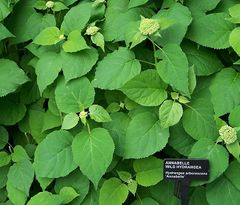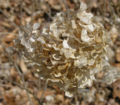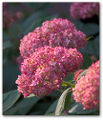Hydrangea arborescens
| Hydrangea arborescens subsp. var. | Wild Hydrangea, Smooth Hydrangea | |||||||||||||||||||||||||||||||||||||||||||||||||||||||
|---|---|---|---|---|---|---|---|---|---|---|---|---|---|---|---|---|---|---|---|---|---|---|---|---|---|---|---|---|---|---|---|---|---|---|---|---|---|---|---|---|---|---|---|---|---|---|---|---|---|---|---|---|---|---|---|---|

|
|
| ||||||||||||||||||||||||||||||||||||||||||||||||||||||
| ||||||||||||||||||||||||||||||||||||||||||||||||||||||||
Hydrangea arborescens, commonly known as Wild Hydrangea or Smooth Hydrangea, is a species of Hydrangea native to eastern North America.
| Standard Cyclopedia of Horticulture |
|---|
|
Hydrangea arborescens, Linn. (H. urticifolia, Hort.). Erect shrub, 4-10 ft.: lvs. long-petioled, ovate, acute or acuminate, rounded or cordate at the base, serrate, green and glabrous on both sides or somewhat pubescent or glaucous beneath, 3-6 in. long: cymes 2-5 in. broad, with none or few sterile fls. June, July. N. J. to Iowa, south to Fla. and Mo.
|
Cultivation
Propagation
Pests and diseases
Cultivars
- The cultivar 'Annabelle' is the best known of this species. It is noted for having very large inflorescens (flower heads)that emerge green turn white and then age to green. The blooms are so large and heavy they often flop to the ground after a rain.
- The cultivar ‘Grandiflora’ has flowers that resemble snowballs, similar to Viburnum plicatum. The blooms are not as large as 'Annabelle' and are typically more irregular or lumpy.
- The cultivar ‘Hayes Starburst’ is a small, weeaked stemed plant with attractive, fully doubled tepals (sterile flowers).
- The cultivar ‘NCAH1’ (syn INVINCIBELLETM Spirit) is the first 'Annabelle' type hydrangea with bright pink flowers. Like the species it is cold hardy, heat tolerant and relaible flowering. The mature stems are stronger than 'Annabelle' and are less likely to flop. This cultivar is also unique in that it continues to produce new flowers after the initial bloom.
Gallery
-
Hills-of-Snow Hydrangea "Grandiflora"
-
Wild Hydrangea v. Annabelle
Hydrangea arborescens -
Flowers of Smooth Hydrangea
-
Flowers of Invincibelle Spirit Hydrangea
References
- Standard Cyclopedia of Horticulture, by L. H. Bailey, MacMillan Co., 1963
External links
- w:Hydrangea arborescens. Some of the material on this page may be from Wikipedia, under the Creative Commons license.
- Hydrangea arborescens QR Code (Size 50, 100, 200, 500)



